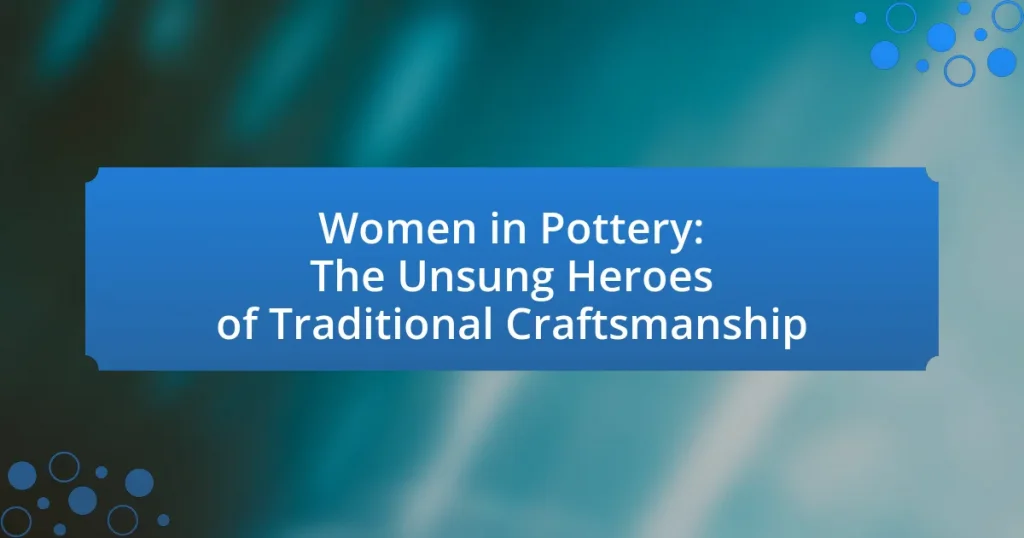Women in pottery are skilled artisans who have historically played a vital role in the craft, often serving as custodians of cultural heritage and traditional techniques. This article explores the significant contributions of women in pottery, highlighting their roles as primary potters in various cultures, the impact of societal perceptions on their involvement, and the challenges they face in gaining recognition. It also examines the evolution of women’s roles in pottery, the innovations they have introduced, and the opportunities available today for aspiring female potters. Through this exploration, the article underscores the importance of acknowledging women’s contributions to pottery as essential to the preservation and evolution of this traditional craft.

Who are the Women in Pottery?
Women in pottery are skilled artisans who have historically contributed to the craft, often preserving traditional techniques and cultural heritage. Throughout various cultures, women have played a crucial role in pottery production, from hand-building to glazing and firing, often passing down knowledge through generations. For instance, in many Indigenous communities, women are the primary potters, creating functional and ceremonial pieces that reflect their cultural identity. This involvement is supported by studies highlighting women’s significant contributions to pottery in regions such as the American Southwest, where they are recognized for their intricate designs and craftsmanship.
What roles have women historically played in pottery?
Women have historically played crucial roles in pottery, primarily as artisans and cultural custodians. In many societies, women were responsible for creating functional pottery for domestic use, such as cooking vessels and storage containers, which were essential for daily life. For instance, in ancient cultures like the Pueblo peoples of North America, women not only crafted pottery but also passed down techniques and designs through generations, preserving cultural heritage. Additionally, archaeological findings indicate that women were often the primary potters in various civilizations, highlighting their integral role in both the craft and community identity.
How did cultural perceptions shape women’s involvement in pottery?
Cultural perceptions significantly shaped women’s involvement in pottery by associating the craft with domesticity and femininity. In many societies, pottery was viewed as an extension of women’s roles in the home, leading to their active participation in creating functional and decorative items. For instance, in ancient cultures such as the Pueblo peoples of the American Southwest, women were the primary potters, reflecting the cultural belief that women were the custodians of family and tradition. This perception not only legitimized their role in pottery but also allowed them to pass down techniques and styles through generations, reinforcing their importance in the craft.
What specific skills do women bring to pottery craftsmanship?
Women bring exceptional skills to pottery craftsmanship, including attention to detail, creativity, and a strong sense of community. Attention to detail allows women to create intricate designs and ensure high-quality finishes, which is essential in pottery. Their creativity fosters innovation in form and decoration, leading to unique and culturally significant pieces. Additionally, women often play a pivotal role in community-based pottery practices, sharing knowledge and techniques that enhance collective craftsmanship. Historical evidence shows that women have been integral to pottery traditions across various cultures, contributing to the preservation and evolution of this art form.
Why are women often considered unsung heroes in this craft?
Women are often considered unsung heroes in pottery due to their significant yet frequently overlooked contributions to the craft. Historically, women have played a crucial role in pottery, often managing the intricate processes of shaping, glazing, and firing ceramics, while their work has been marginalized in favor of male counterparts who received more recognition. For instance, in many cultures, women were the primary potters, responsible for creating essential household items, yet their names rarely appeared in historical records or art narratives. This lack of acknowledgment highlights the systemic biases that have rendered their contributions invisible, despite the fact that women have been pivotal in preserving traditional techniques and innovating new styles within the craft.
What challenges have women faced in gaining recognition?
Women in pottery have faced significant challenges in gaining recognition, primarily due to historical gender biases and societal norms that undervalue women’s contributions in craftsmanship. For centuries, pottery has been perceived as a male-dominated field, leading to the marginalization of women’s work and achievements. Research indicates that women artisans often receive less visibility and fewer opportunities for professional advancement compared to their male counterparts, which is evident in the lack of representation in exhibitions and awards. Additionally, cultural stereotypes have perpetuated the notion that pottery is a lesser art form when practiced by women, further hindering their recognition.
How have women’s contributions been overlooked in pottery history?
Women’s contributions have been overlooked in pottery history primarily due to historical biases that favored male artisans and a lack of documentation regarding women’s roles. Despite women being integral to pottery production, especially in traditional and indigenous contexts, their work often went unrecognized in historical records. For instance, in many cultures, women were the primary potters responsible for creating essential household items, yet their contributions were frequently attributed to anonymous artisans or overshadowed by male counterparts who were documented in art history. This pattern is evident in archaeological findings where women’s pottery styles and techniques remain uncredited, highlighting a systemic undervaluation of their craftsmanship.
What impact do women have on traditional pottery practices?
Women significantly influence traditional pottery practices by serving as primary artisans and custodians of cultural heritage. Their roles often encompass the entire pottery-making process, from sourcing materials to shaping and decorating the final products. For instance, in many cultures, women have historically been the ones to pass down techniques and styles through generations, ensuring the continuity of traditional methods. Research indicates that in regions such as Oaxaca, Mexico, women potters not only create functional items but also infuse their work with cultural narratives, thereby preserving community identity. This impact is evident in the way women’s pottery often reflects local traditions, social values, and artistic expressions, making them essential to the survival and evolution of traditional pottery practices.
How do women’s techniques differ from those of their male counterparts?
Women’s techniques in pottery often emphasize intricate detailing and functional design, contrasting with the more robust and utilitarian approaches typically employed by their male counterparts. Research indicates that women frequently utilize hand-building methods, such as coiling and pinching, which allow for greater creativity and personalization in their work. In contrast, men are more likely to use wheel-throwing techniques, which can produce uniform shapes but may limit individual expression. A study by the American Craft Council highlights that women artisans often prioritize community and storytelling in their pottery, reflecting cultural narratives, while men may focus on technical precision and marketability. This distinction illustrates how gender influences artistic expression and craftsmanship in pottery.
What innovations have women introduced in pottery?
Women have introduced significant innovations in pottery, including the development of unique glazing techniques and the incorporation of intricate decorative styles. For instance, women potters in various cultures have historically utilized natural materials for glazes, leading to distinctive finishes that reflect local resources and traditions. Additionally, women have often been the custodians of traditional designs, adapting them to contemporary aesthetics while preserving cultural heritage. This blend of innovation and tradition has been documented in studies highlighting the role of women in pottery across different regions, such as the work of women artisans in Native American communities, who have revitalized ancient techniques to create both functional and artistic pieces.

How has the role of women in pottery evolved over time?
The role of women in pottery has evolved from being primarily domestic artisans to recognized contributors in both traditional and contemporary pottery practices. Historically, women were often responsible for creating pottery for household use, which included functional items like cooking vessels and storage jars, reflecting their roles in family and community life. Over time, as societies progressed, women began to gain visibility in the pottery field, participating in artistic movements and gaining recognition for their craftsmanship.
In the 20th century, the feminist movement further propelled women into the spotlight, leading to increased opportunities for women potters to showcase their work in galleries and exhibitions. This shift is evidenced by the rise of influential female potters, such as Lucie Rie and Beatrice Wood, who challenged traditional norms and expanded the artistic boundaries of pottery. Today, women are not only key figures in preserving traditional pottery techniques but also innovators in contemporary ceramic art, contributing to a diverse range of styles and practices globally.
What historical events influenced women’s participation in pottery?
Women’s participation in pottery has been significantly influenced by historical events such as the Industrial Revolution, which shifted production methods and allowed women to engage in pottery as a form of economic contribution. During this period, many women began to work in pottery factories, gaining independence and financial autonomy. Additionally, the Arts and Crafts Movement in the late 19th century emphasized traditional craftsmanship, encouraging women to reclaim pottery as a personal and artistic expression. These movements collectively provided women with opportunities to participate in pottery, both as a livelihood and as a means of artistic expression, thereby shaping their role in this craft throughout history.
How did the industrial revolution affect women’s roles in pottery?
The Industrial Revolution significantly transformed women’s roles in pottery by shifting them from traditional home-based production to factory settings. As mechanization increased, women began to work in pottery factories, where they took on roles such as decorators and assemblers, which allowed them to earn wages and gain a degree of financial independence. Historical records indicate that by the mid-19th century, women constituted a substantial portion of the workforce in pottery manufacturing, particularly in regions like Staffordshire, England, where factories proliferated. This transition not only altered the economic landscape for women but also contributed to the gradual recognition of their contributions to the craft, marking a pivotal change in societal perceptions of women’s work in pottery.
What modern movements are empowering women in pottery today?
Modern movements empowering women in pottery today include initiatives like the Women’s Studio Workshop and the Clay Studio’s programs, which focus on providing resources, education, and community support specifically for female potters. These organizations facilitate workshops, mentorship opportunities, and exhibitions that highlight women’s contributions to the craft. For instance, the Women’s Studio Workshop has been instrumental in promoting female artists through grants and residencies, enabling them to develop their skills and gain visibility in a traditionally male-dominated field. Additionally, social media platforms have fostered a global community where women potters can share their work, connect with others, and inspire each other, further enhancing their presence in the pottery world.
How do contemporary women artists redefine pottery?
Contemporary women artists redefine pottery by integrating personal narratives, cultural commentary, and innovative techniques into their work. These artists challenge traditional notions of pottery, often using the medium to explore themes such as identity, gender, and social issues. For instance, artists like Magdalene Odundo and Grayson Perry utilize their backgrounds and experiences to create pieces that reflect their unique perspectives, thereby expanding the boundaries of what pottery can represent. This shift not only elevates the status of pottery as an art form but also highlights the contributions of women in a historically male-dominated field.
What themes do modern women potters explore in their work?
Modern women potters explore themes of identity, femininity, and cultural heritage in their work. These themes reflect personal narratives and societal issues, often addressing the intersection of traditional craftsmanship and contemporary art. For instance, many women potters incorporate elements that challenge gender norms and celebrate female experiences, drawing from historical contexts and personal stories. This focus on identity and heritage is evident in the works of artists like Magdalene Odundo, who blends African traditions with modern techniques, emphasizing the importance of cultural roots in contemporary pottery.
How are women using pottery as a form of activism?
Women are using pottery as a form of activism by creating works that address social issues, promote cultural heritage, and empower marginalized communities. Through their pottery, women artists often convey messages related to gender equality, environmental sustainability, and cultural identity. For instance, initiatives like the “Women’s Clay Collective” in the United States focus on providing a platform for women potters to share their stories and advocate for social change through their art. Additionally, women in various cultures use traditional pottery techniques to preserve and celebrate their heritage, thereby resisting cultural erasure and asserting their identities. This blend of artistry and activism highlights the role of pottery as a medium for social commentary and community engagement.

What are the challenges and opportunities for women in pottery today?
Women in pottery today face challenges such as gender bias, limited access to resources, and underrepresentation in the industry. Despite these obstacles, opportunities exist for women to gain visibility through community workshops, online platforms, and collaborations that promote their work. For instance, organizations like the American Craft Council highlight female artisans, providing them with a platform to showcase their skills and connect with broader audiences. Additionally, the rise of social media has enabled women potters to market their creations directly to consumers, fostering entrepreneurship and creative expression.
What barriers do women face in the pottery industry?
Women in the pottery industry face several barriers, including limited access to resources, lack of representation, and cultural constraints. Limited access to financial resources and training opportunities hinders women’s ability to start or expand their pottery businesses. Additionally, the underrepresentation of women in leadership roles within the industry perpetuates gender biases and restricts networking opportunities. Cultural constraints, such as traditional gender roles, often discourage women from pursuing pottery as a viable career, leading to a lack of recognition for their contributions. These barriers collectively impact women’s participation and success in the pottery industry.
How does access to resources impact women potters?
Access to resources significantly impacts women potters by determining their ability to acquire materials, tools, and training necessary for their craft. When women potters have access to quality clay, glazes, and equipment, they can produce higher-quality work, which can lead to increased sales and economic independence. For instance, a study by the International Fund for Agricultural Development found that women with access to financial resources and training in pottery techniques were able to increase their income by up to 30%. This access not only enhances their craftsmanship but also empowers them socially and economically within their communities.
What role does mentorship play in supporting women in pottery?
Mentorship plays a crucial role in supporting women in pottery by providing guidance, skill development, and networking opportunities. Experienced mentors can share technical knowledge and artistic techniques, which are essential for women to enhance their craft and gain confidence in their abilities. For instance, mentorship programs have been shown to increase participation rates among women in traditionally male-dominated fields, including pottery, by fostering a supportive community that encourages creativity and innovation. Additionally, studies indicate that women who engage in mentorship relationships are more likely to pursue leadership roles and entrepreneurial ventures within the pottery industry, thereby contributing to the overall growth and recognition of women in this craft.
What opportunities exist for women in the pottery field?
Women in the pottery field have opportunities in various areas, including artistic expression, entrepreneurship, and community engagement. Many women create unique pottery pieces that reflect cultural heritage and personal style, allowing them to establish a distinct artistic identity. Additionally, women can start their own pottery businesses, selling their work online or at local markets, which has been facilitated by the rise of e-commerce platforms. Community workshops and classes also provide women with the chance to teach pottery skills, fostering a supportive environment for learning and collaboration. According to a report by the American Craft Council, women represent a significant portion of artisans in the craft sector, highlighting their vital role in the pottery community.
How can women leverage social media to promote their pottery work?
Women can leverage social media to promote their pottery work by creating visually appealing content that showcases their craftsmanship and engages with their audience. Platforms like Instagram and Pinterest are particularly effective for visual storytelling, allowing women to share high-quality images and videos of their pottery, behind-the-scenes processes, and personal stories that resonate with potential customers.
Engagement strategies such as using relevant hashtags, collaborating with other artists, and participating in pottery-related challenges can increase visibility. According to a 2021 survey by Hootsuite, 54% of social media users use platforms to research products, indicating that a strong online presence can directly influence purchasing decisions. By consistently posting and interacting with followers, women can build a loyal community that supports their pottery business.
What are some successful initiatives supporting women in pottery?
Successful initiatives supporting women in pottery include programs like the Pottery for Women initiative in India, which provides training and resources to female artisans, enabling them to create and sell their pottery. Additionally, organizations such as the Women’s Studio Workshop in New York offer workshops and grants specifically for women potters, fostering skill development and artistic expression. These initiatives have been shown to increase economic independence and promote cultural heritage among women artisans, as evidenced by the rise in female-led pottery businesses in regions where these programs are implemented.
What practical tips can aspiring women potters follow?
Aspiring women potters can enhance their skills by practicing regularly, seeking mentorship, and participating in pottery workshops. Regular practice allows for the development of techniques and muscle memory essential for pottery. Mentorship from experienced potters can provide valuable insights and guidance, helping to navigate challenges in the craft. Additionally, attending workshops offers hands-on experience and exposure to different styles and methods, which can broaden an aspiring potter’s skill set. These strategies are supported by the fact that consistent practice and community engagement are key factors in mastering any craft, as highlighted in various studies on skill acquisition in the arts.


